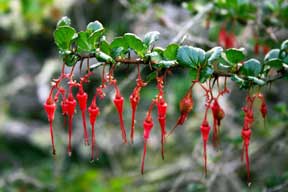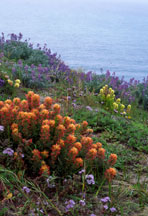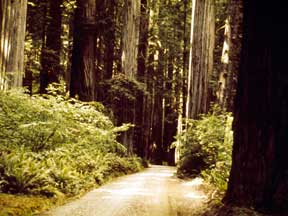
INTRODUCTION TO CALIFORNIA PLANT LIFE
Integrative Biology 102/102L, University of California, Berkeley, Spring Semester

COURSE DESCRIPTION (modified slightly from catalog):
Integrative Biology 102 and 102L (NOTE: Both must be taken concurrently!). Introduction to California plant life (4 units). Two one-hour lectures and two three-hour labs per week and at least two Saturday field trips. Prerequisites: Biology 1B (or equivalent) or consent of the instructor. The relationship of the main plant groups and the plant communities of California to climate, soils, vegetation, geological and recent history, and conservation. The lab focuses on the main plant groups and the major plant families in California, and the use of keys to identify introduced and especially native pteridophytes, conifers, and particularly flowering plants of the state.
ADDITIONAL INFORMATION
Instructor: Dr. Dean Kelch
Email: dkelch@berkeley.edu
Office Hours: Fridays, 12:00 - 12:45 pm
University and Jepson Herbaria, 1001 Valley Life Sciences Building 2465
SOME LECTURE AND LAB TOPICS:
Due to its topographic diversity, California has an incredible diversity of plant communities that can be arranged geographically starting in central California on the coast, moving eastward across the Coast Ranges, Central Valley, and the Sierra Nevada and then south into the deserts of southern California, to wit (25 major communities and 19 minor communities, the main or most important ones italicized; * = aquatic and moist-habitat communities):
Intertidal-Subtidal*
Coastal Beach and Dune  Coastal Salt Marsh*
Coastal Salt Marsh*
Brackish Marsh*
Northern Coastal Prairie
Coastal Scrub
Closed-cone Coniferous Forest, including Pygmy Forest
Northern Coastal Coniferous Forest, including Redwood Forest
Mixed Evergreen Forest, including Douglas Fir Forest
Chaparral, including Montane Chaparral
Oak Woodland
Annual Grassland
Perennial Grassland, and other grasslands
Azonal (scattered), rather localized, freshwater aquatic and moist-habitat communities (Vernal Pool*; Riparian Woodland*; Freshwater Marsh*; Lakes, Ponds, and Sloughs*; Bogs*; Meadows*; Aspen Woodland*)
Lower Montane Coniferous Forest
Upper Montane Coniferous Forest
Subalpine Coniferous Forest
Alpine vegetation, including Alpine Fellfield and Alpine Meadow*
Pine-Juniper Woodland
Sagebrush Scrub
Blackbush Scrub
The classic desert communities:
Joshua Tree Woodland, Creosote Bush Scrub, Saltbush Scrub, Alkali Sink Scrub
Coverage will also include related vegetation types in adjacent areas such as Baja California, Oregon, Nevada, and Arizona, especially those areas therein that involve elements of the California Floristic Province. We will thus see how information learned about California can be applied outside California. The labs and field trips will focus on the important families and genera of vascular plants in California. Disturbance of the indigenous vegetation, threatened species and conservation, and restoration of the native vegetation will be continual themes throughout the course in both the lab and especially the lecture.
A 1994-vintage summary of the features of the plant communities of California is available via the Geography Department, UC Berkeley: http://geography.berkeley.edu/ProjectsResources/CalPlants/califplanttable.html
Photos of California plants are available online through http://elib.cs.berkeley.edu/photos/
| Plant lists from the IB 102 labs with links to Calphoto images |
|---|
The lectures (27) will treat these topics, roughly in this order:
Basic vegetative morphology
The naming of organisms and the use of keys
Phylogeny and angiosperm evolution
Various lectures on lycophytes, pteridophytes, conifers, and angiosperms (the angiosperms are emphasized)
Ecology of organ and whole-plant modifications for severe habitats
Characteristics and effects of weeds
Fire and flood; two constant phenomena in California
The many vegetation types (see above ) of California and adjacent regions from the perspective of:
The three-hour labs (28) will involve the following:
Learning basic terminology of vegetative and reproductive morphology of vascular plants
Practice keying of various plant taxa
Learning the distinctive features of about 12 plant families, 200 plant genera, and major species of pines and oaks.
Six or seven mandatory local field trips within the normally scheduled three-hour lab period to:
You must provide your own transportation to these field trips. Please carpool (your GSI may arrange to go as a class by carpooling from campus)! These field trips are scheduled in the beginning of the week and will be held even during light rain. If the weather is very bad, a field trip will be rescheduled to the end of the week. Check the door of your lab an hour before your scheduled lab for a notice giving the latest details about any postponements, etc. There will be quizzes on most of these trips.
In addition, the laboratory component of the course will involve:
Two, mandatory, all-day (8:00 AM sharp to circa 7:30 PM ) weekend field trips in April to:
The course will provide transportation for these field trips. You must bring lunch, water, and appropriate field clothing.
